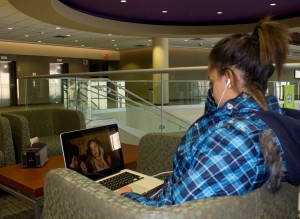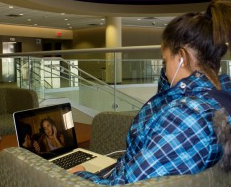In the last month, a St. Thomas Information Resources and Technology report estimated that 28 percent of bandwidth on campus came from students streaming Netflix, and another 12 percent came from flash video use.
To keep up with students’ increasing Internet usage levels, IRT already doubled the Internet campus connection Sept. 27 from 500 megabits per second to 1000. Popularity of video streaming from sites like Netflix has contributed to the increase.
Sam Levy, vice president of IRT, said the Internet’s growth and the introduction of video streaming sites like Netflix has caused an extreme increase in the size of the campus Internet connection in the last 11 years.
“In 2001, when I first started here, we were at six megabits per second. We are now at 1,000,” Levy said. “Of course the whole Internet has grown up in that time … but it’s still a huge increase.”

Levy said if Internet usage levels continue to increase on campus, students could end up paying for it.
“There is a cost involved in this, students pay a technology fee, that’s part of the general fund of the university, but certainly it is among the things that help pay for Internet provision,” Levy said. “No one wants to raise fees.”
While Netflix has been the most popular choice for streaming video on campus, the company itself has not been so popular, ending up on 24/7 Wall St.’s “Ten Most Hated Companies in America” list in January as a result of raising customer rates by 60 percent in August 2011.
Despite the list, some students said Netflix is worth the price.
“It’s way cheaper than cable,” senior Kristen Wise said.
Sophomore Allen-Michael Muench said he uses Netflix for a variety of reasons including the fact that he isn’t paying the bill.
“My parents are the ones that pay for it,” Muench said. “There’s a lot of variability in what they (Netflix) offer.”
Heavy streaming on campus uses a lot of bandwidth, something Levy said students have complained about in the past.
“If you’re a student sitting out there trying to get online to do research or complete an assignment … and the people nearby you are sucking down a lot of bandwidth from Netflix, you can’t get the speed you need to get your work done,” Levy said.
Although many students said Netflix is an Internet convenience, it doesn’t come without problems.
“Any time you start looking at increasing and increasing and increasing (the Internet connection), you have to say, ‘what is the value of that from a cost perspective?’” Levy said.
Increasing the Internet any higher than the current 1,000 megabits (one gigabit) would result in big changes to the existing Internet structure, Levy said.
“If we go above a gigabit for the Internet, we have to change a whole lot of our network infrastructure on campus,” Levy said. “Eventually that will happen, but I would rather have it be eventually than next year.”
Levy said students should be aware of the heavy video streaming they are doing in order to preserve bandwidth, and should exit out of sites that are streaming once they are finished watching.
“It’s like asking people to turn off the lights to save on utilities,” Levy said. “It really gets down to the same equation.”
While the growing Internet will provide a faster connection for students, Levy said there should be a balance between the different uses of campus Internet.
“It’s a balancing situation; ‘yes’ to social and recreational, ‘yes’ to academic and scholarly,” Levy said.
Gabrielle Martinson can be reached at mart5649@stthomas.edu.



